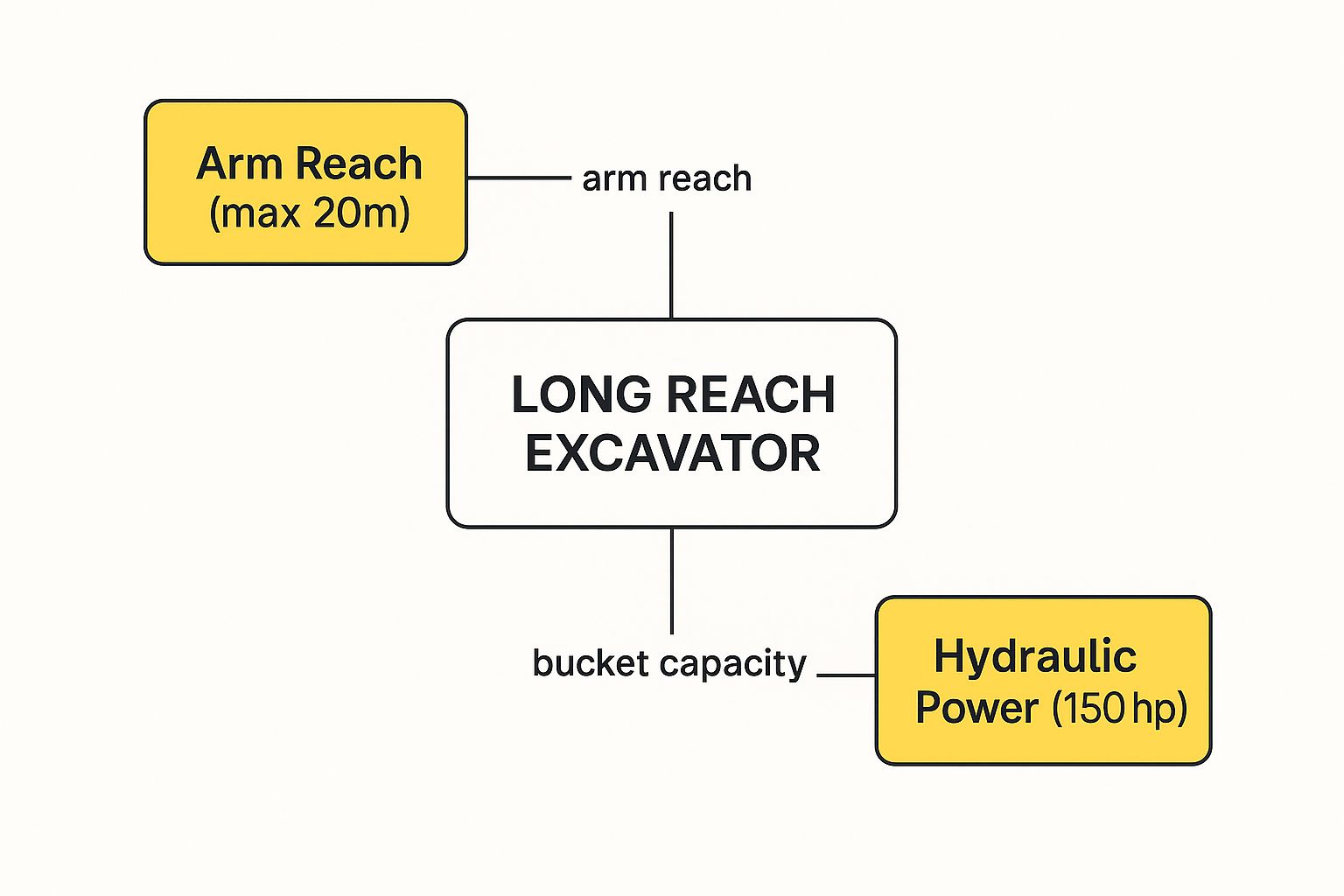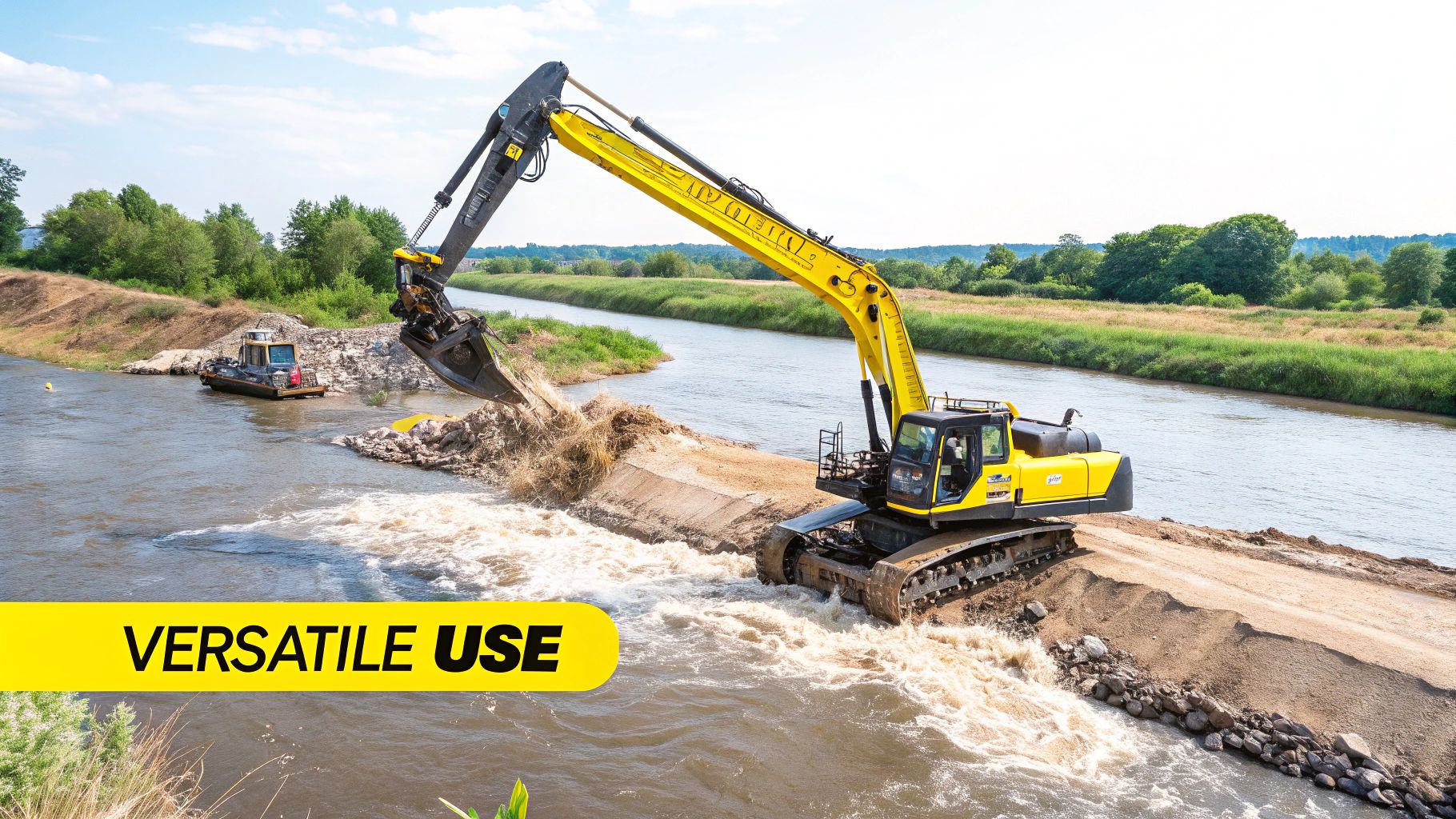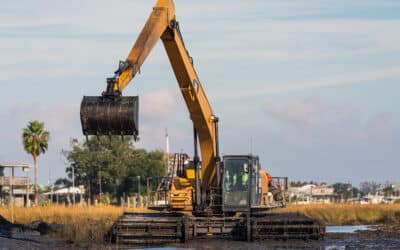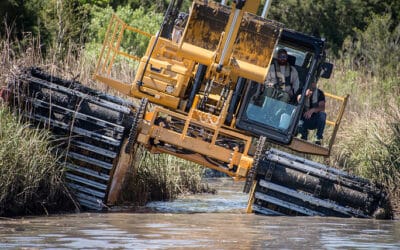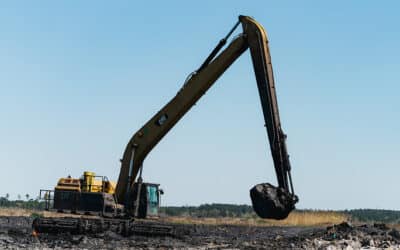When a project is just beyond the reach of standard equipment, finding the right long reach excavator for sale can be the difference between success and failure. These are not everyday diggers. They are specialized machines engineered with an extended boom and arm, giving you the power to tackle jobs that would otherwise be impossible, such as dredging, high-reach demolition, or deep foundation work.
Your Guide to Finding the Right Long Reach Excavator
A long reach excavator is the specialist you call when standard machines simply cannot bridge the gap. While not intended for every task on a job site, for specific, challenging applications, it is indispensable. Its true value lies in its ability to perform precise work from a safe distance, keeping crews out of harm's way and protecting the surrounding environment.
If you are a decision-maker looking for a real solution to a complex operational challenge, you are in the right place. We understand that purchasing heavy machinery is a significant investment, so our goal is to provide a clear, practical roadmap for choosing the right machine. We will cover everything from basic components to specific applications, helping you identify the exact features your projects demand.
Understanding the Market and Its Growth
The growing demand for these powerful machines highlights their importance in modern construction, environmental remediation, and infrastructure projects. Valued at approximately USD 4.5 billion in 2024, the global market for long reach excavators is on an upward trend. This figure reflects a real industry shift toward specialized equipment that can handle tough jobs more efficiently and safely.
A long reach excavator is not just an excavator with a longer arm. It is an engineered system where every component, from the counterweight to the hydraulic system, is optimized for stability and extended performance.
What This Guide Will Cover
We have designed this guide to provide you with the essential knowledge needed before you even start looking at listings for a long reach excavator for sale. The goal is to give you the confidence to make a smart decision that boosts your capabilities and provides a solid return on investment.
For particularly challenging projects in wet, saturated environments, it is also important to understand how this equipment integrates with other specialized gear. You can see how amphibious capabilities push operational boundaries by exploring our inventory of marsh equipment for sale.
Here’s what we will cover:
- Core Components: We'll break down the anatomy of a long reach excavator.
- Key Applications: A look at where these machines truly shine.
- Selection Criteria: Your checklist for picking the perfect model.
- Maintenance Essentials: How to protect your investment for the long haul.
Understanding the Anatomy of a Long Reach Excavator
What truly sets a long reach excavator apart from the standard digger on a construction site? It is a common misconception that it is just a regular excavator with a longer arm bolted on. The reality is far more sophisticated.
These machines are engineered from the ground up as a complete system. Every part, from the tracks to the bucket, is designed to work in harmony, delivering incredible power and precision over distances that would be unthinkable for a standard machine.
The Extended Boom and Arm
The most obvious difference, of course, is the extended boom and arm. This is not simply a stretched-out version of a standard setup, it is a complete re-engineering.
Manufacturers use lighter, high-tensile steel to construct these longer components, maximizing strength without adding unnecessary weight. This careful balance is critical. It prevents the enormous stress of a fully extended, loaded arm from overwhelming the machine's core structure and hydraulics.
This unique design allows an operator to dredge a canal from the bank, dig a deep foundation, or demolish a tall building, all while keeping the machine safely on solid ground. This provides a massive boost to both safety and efficiency on challenging job sites.
To put it in perspective, let's look at a direct comparison.
Standard vs Long Reach Excavator Key Differences
This table breaks down the fundamental distinctions between the two machine types, highlighting why a long reach excavator is a specialist tool.
| Feature | Standard Excavator | Long Reach Excavator |
|---|---|---|
| Primary Function | General digging, trenching, lifting | Specialized, long-distance tasks |
| Boom/Arm Length | Shorter, for power and leverage | Significantly longer, for reach |
| Counterweight | Standard size for balance | Heavily oversized for stability |
| Hydraulic System | Standard pressure and flow | High-capacity, high-pressure system |
| Bucket Size | Larger, for bulk material moving | Smaller, to reduce weight at full reach |
| Undercarriage | Standard | Often wider for a more stable base |
As you can see, every modification on the long reach model is a trade-off designed to extend its working envelope safely and effectively.
The Critical Role of the Counterweight
If the long arm is the star of the show, the counterweight is the unsung hero. Think of it like the ballast in a cargo ship. Without that heavy, stabilizing force, the ship would tip over in the first big wave. The same principle applies here.
When the long boom extends with a full bucket of material, it creates immense leverage that would easily topple a standard excavator. The long reach model is equipped with a much heavier, purpose-built counterweight that provides the opposing force needed to keep the machine firmly planted.
This is not just a feature, it is a non-negotiable requirement for safe and confident operation.
Powering the Extended Reach
A long arm is useless without the power to control it. That is where the high-capacity hydraulic system comes in. A long reach machine needs a much more powerful hydraulic setup to push fluid through longer hoses and actuate the larger cylinders required to move its massive boom.
This system is specially calibrated to handle the increased demand and deliver consistent, smooth power. Here’s what makes it different:
- Higher Pressure Settings: The hydraulic pumps are tuned to run at higher pressures, compensating for the distance and weight of the components.
- Larger Cylinders: The cylinders that move the boom, arm, and bucket are bigger to generate the necessary force at maximum extension.
- Enhanced Cooling: Pushing that much hydraulic fluid around generates significant heat. These excavators come with robust cooling systems to keep temperatures in check and protect the hydraulic fluid from breaking down.
This specialized hydraulic system ensures that even when the bucket is 60 feet away, the operator has the smooth, responsive control needed for precise work, like grading a distant slope or carefully dismantling a structure piece by piece.
Ultimately, a long reach excavator is a masterclass in balanced engineering. From the undercarriage to the hydraulics, every component is part of a deliberate design to turn a seemingly impossible job into a manageable task. Understanding how these parts work together is the first step toward choosing the right machine for your project.
To see how these machines can be made even more versatile, check out some of the most popular marsh runner attachments that can take their capabilities to the next level.
Where Long Reach Excavators Make the Difference
Understanding the mechanics of a long reach excavator is one thing, but seeing it in action is where its true value becomes clear. These machines are purpose-built problem solvers, designed for jobs where extreme distance, depth, or height would otherwise bring a project to a standstill.
They thrive in environments that are too hazardous or inaccessible for standard equipment. From dredging a riverbed to dismantling a high-rise, a long reach excavator turns daunting challenges into manageable tasks. Let’s dive into the real-world scenarios where these specialized machines are not just beneficial, they are an absolute necessity.
Waterway Dredging and Management
Dredging is one of the most common applications for a long reach excavator. Over time, rivers, canals, and harbors inevitably fill with silt, sand, and other debris. This buildup can restrict water flow, make channels too shallow for navigation, and increase the risk of flooding.
The primary challenge is that this work often must be done from the bank, where the ground may be soft, unstable, or environmentally sensitive. A standard excavator lacks the reach to perform this work effectively from the shoreline.
This is precisely where the long reach model excels. Positioned securely on solid ground, its extended boom can reach far into the waterway, methodically clearing sediment and obstructions with precision. This is critical for:
- Clearing Clogged Waterways: Restoring proper depth and flow by removing accumulated silt.
- Strengthening Shorelines: Placing heavy riprap or other materials to prevent erosion without driving on the delicate bank itself.
- Environmental Cleanup: Carefully removing contaminated sediment from a safe and stable distance.
By working from the shoreline, a long reach excavator minimizes the environmental footprint and often eliminates the need for expensive barges or temporary causeways.
High-Reach Demolition Projects
Demolishing a multi-story building, especially in a dense urban area, requires surgical precision. Traditional demolition methods can be high-risk, creating excessive dust and putting crews in immediate danger.
A long reach excavator offers a much safer, more controlled approach. Outfitted with an attachment like a shear or a pulverizer, it can carefully dismantle a building from the top down, piece by piece. The operator sits at a safe distance, systematically deconstructing the structure without threatening adjacent properties.
The extended reach allows an operator to strategically dismantle a building while minimizing vibration and impact on neighboring properties, a crucial factor in urban demolition projects.
Deep Trenching for Pipelines and Utilities
Installing large-diameter pipes or deep sewer lines requires digging trenches far beyond the capability of a standard machine. A long reach excavator can dig to significant depths while keeping its tracks on stable ground. This often reduces the need for extensive shoring or benching, saving considerable time and money.
It can also cast excavated soil well away from the trench edge, a massive safety benefit that helps prevent cave-ins. For any large-scale infrastructure project, that extended digging envelope is a game-changer.
The worldwide fleet of long reach excavators has now grown to over 15,000 units, a surge driven by major infrastructure and urbanization projects. The Asia-Pacific region alone accounts for roughly 42% of this market, thanks to its rapid development.
Land Reclamation and Slope Finishing
Creating usable land from swamps or coastal areas is another ideal application for a long reach excavator. These projects involve moving massive amounts of soil or fill over long distances, often across unstable ground. The excavator can sit on a solid pad and place material with precision exactly where it is needed.
The same principle applies to grading steep slopes for new roads or building sites. Safety is paramount. The machine’s ability to work from a distance allows operators to shape and finish the slope without having to position the excavator precariously close to the edge. This ensures a stable, professionally finished grade that resists erosion.
How to Choose the Right Excavator for Your Project
Selecting the right heavy machinery is always a critical decision. When you’re evaluating a long reach excavator for sale, the stakes are even higher. These are specialized machines built for demanding work, and making the right choice is crucial for your bottom line.
Think of it less as a purchase and more like adding a key specialist to your team. The right long reach excavator will make your sites safer, your crews more productive, and allow you to bid on projects you couldn't tackle before. Let's walk through the essential considerations to help you make a smart, confident decision.
Defining Your Project Requirements
Before you browse listings or speak with dealers, the most important work happens within your own organization. You must be realistic about what your projects truly demand. A generic spec sheet is not enough.
Start by analyzing your past and future jobs to determine your absolute maximum reach and digging depth requirements. Are you typically dredging canals that need a 60-foot horizontal reach? Or are you performing demolition work that requires a 50-foot vertical reach? Document these figures. This is not a wish list, it is the foundation of your entire search.
Your own project data is your most valuable tool. A machine that barely meets your current needs will limit you tomorrow. It is always wise to build in extra capacity for the bigger jobs you want to win in the future.
Operating Weight and Site Logistics
The machine's operating weight is another critical piece of the puzzle. It affects everything from transportation to on-site performance. A heavier machine usually offers more stability, but it also brings logistical challenges.
You need to ask a few key questions:
- Transportation: Can your current lowboy trailers handle this machine? A heavier excavator may require special permits, pilot cars, and complex route planning, all of which add to the cost.
- Ground Conditions: Where will this machine be working? Soft soil, swampy ground, and compacted earth all behave differently. You must match the machine's ground pressure to your typical site conditions to avoid getting stuck.
- Site Access: Consider the tight spots. Will a massive, heavy machine fit through the access points on your jobs? Getting stopped at the gate is a terrible way to start a project.
Balancing weight, stability, and logistics is what separates a good purchase from a future problem.
Hydraulic Power and Attachment Compatibility
Ultimately, a long reach excavator is only as useful as the attachments it can power. The hydraulic system is the heart of the operation, supplying the flow and pressure needed to run everything from a simple bucket to heavy-duty shears and hammers.
When evaluating a machine, you must confirm that its hydraulic output can handle the tools you need. An underpowered system leads to sluggish performance, low productivity, and potential damage to expensive attachments. Ensure it has the correct auxiliary hydraulic lines to support your equipment.
This is even more critical when you're considering a used long reach excavator for sale. The previous owner may have made modifications you are unaware of. Always request the spec sheet for the hydraulic pump and, if possible, see it operate during an inspection.
New vs. Used: A Strategic Decision
The choice between new and used often seems to be about the price tag, but there is much more to consider. Each option has significant pros and cons that extend far beyond the initial investment.
To help you think through this, here's a quick checklist covering the most important factors.
Decision Checklist for Buyers
| Evaluation Criteria | Key Questions to Ask | Why It Matters |
|---|---|---|
| Initial Investment | How does the upfront cost fit into my capital expenditure budget? | A used machine can free up capital for other needs, but may come with higher long-term costs. |
| Warranty & Support | What level of warranty and dealer support is included? | A new machine's warranty provides peace of mind and predictable maintenance costs for the initial years. |
| Technology & Features | Does the machine have modern telematics, safety features, and fuel-efficiency tech? | Newer models often offer superior operational efficiency and safety features that can lower operating costs. |
| Maintenance History | If used, is a complete and verifiable maintenance log available? | A detailed history reveals how well the machine was cared for and helps identify potential future problems. |
| Hours of Operation | How many hours are on the machine, and what kind of work was it doing? | High hours in a severe application like demolition cause more wear than the same hours in a light-duty task. |
A well-maintained used machine from a top-tier brand can be an incredible value. However, a thorough, hands-on inspection is non-negotiable. Look for stress cracks or fresh welds on the boom and arm, check for hydraulic leaks, and closely examine the undercarriage. Spending a few hundred dollars on a professional third-party inspection is a smart investment that could save you tens of thousands down the road.
Going Where No Machine Has Gone Before: The Amphibious Advantage
Many jobs that require a long reach excavator are in places you would not want to walk, let alone operate a 50-ton machine. We are talking about swamps, marshes, riverbanks, and saturated coastal areas where the ground is more liquid than solid.
Standard tracks will sink almost instantly. In these conditions, a specialized undercarriage is not just an advantage, it is the only way to get the job done. For these nearly impossible environments, the solution is an amphibious hydraulic undercarriage. It essentially transforms your excavator into a go-anywhere machine that bridges the gap between land and water.
How It Floats: The Secret is in the Pontoons
Imagine an excavator that can literally float across a channel and then crawl onto soft mud without leaving a trace. That is the power of an amphibious system. These undercarriages replace standard tracks with a pair of large, sealed pontoons fitted with heavy-duty track chains.
This innovative design distributes the machine’s immense weight over a huge surface area. The result is incredibly low ground pressure, often less than that of a human footprint. This allows the excavator to work in sensitive wetlands with minimal environmental impact and navigate terrain that would swallow conventional equipment.
When you combine the incredible reach of a long boom with the all-terrain capability of an amphibious undercarriage, you create a machine with unparalleled operational freedom. It is a game-changing combination for tackling the toughest jobs in the worst environments.
Where This Combination Shines
This duo of long reach and amphibious mobility is a critical tool for specific, high-stakes industries. It provides practical solutions to complex problems that would otherwise be logistical nightmares.
Here are a few areas where this setup truly excels:
- Environmental Cleanup: When you need to remove contaminated silt from a swamp, you can drive the excavator directly to the location without building expensive access roads or temporary work platforms.
- Coastal Restoration: For projects like planting mangroves or shoring up coastlines, the machine can work precisely in tidal zones, even while floating in shallow water.
- Dredging and Waterway Maintenance: It is perfect for clearing out canals and remote ponds where you cannot access a traditional dredging barge. The excavator simply wades in and gets to work.
- Pipeline Work: Laying or repairing pipelines through marshlands becomes infinitely easier. The amphibious excavator provides a stable, mobile platform for trenching and moving pipe, keeping the project on schedule regardless of wet conditions.
The Wilco Engineered Advantage
Pairing a long reach excavator with the right undercarriage is a strategic move that massively expands your machine's capabilities. In these demanding environments, you need a system that is tough, reliable, and built to withstand abuse. To learn more about how these incredible systems are designed and built, check out our in-depth guide to amphibious hydraulic undercarriages.
By combining these two technologies, you get one piece of equipment that solves two of the biggest challenges in heavy civil work: extreme reach and impossible terrain. It is a synergy that makes the most challenging jobs entirely possible.
Keeping Your Investment Running: Maintenance and Safety
Purchasing a long reach excavator is a significant investment, but the real work begins after delivery. To get the most out of your machine for years to come, you must be equally serious about maintenance and safety.
Proper care is not just about protecting the machine. It is about protecting your operators, your timelines, and your bottom line. A well-inspected and properly maintained excavator is one that is ready to perform safely and efficiently every day.
Why Long Reach Maintenance is Different
You cannot simply follow the standard excavator maintenance playbook. The sheer length of a long reach boom and arm creates a massive lever, putting incredible stress on certain parts of the machine. This unique design demands a more specialized maintenance routine.
Your daily walk-arounds must be laser-focused on these high-stress areas. This means a careful search for any signs of metal fatigue, like hairline cracks in the welds, especially where the boom meets the machine. Greasing every pivot point is not optional, it is the only way to prevent excessive wear and tear.
A disciplined maintenance routine is not an expense, it is an investment in uptime. Industry data consistently shows that a solid preventative maintenance program can reduce equipment failures by over 70%. That translates directly into fewer budget-busting delays on the job site.
Here is a practical checklist to keep your long reach in top form:
- Hydraulic System Health: Walk the boom and arm daily. Look for leaks, scuffs, or kinks in the hydraulic lines. Those long hoses are exposed and take a beating.
- Structural Weak Spots: Make it a weekly habit to closely inspect the welds where the boom and arm connect, and where they join the excavator base. These joints bear the brunt of the force.
- Counterweight Check: Before every shift, ensure the counterweight is bolted on tightly and has not shifted. It is key to the machine's balance and your operator's safety.
- Undercarriage Care: Keep the undercarriage clean from packed mud and debris. This not only prevents premature wear but also makes it easier to spot a loose track pad or a worn roller before it becomes a major problem.
Essential Safety for the Operator
Placing an operator in the cab of a long reach excavator is not like handing them the keys to a standard machine. The physics are entirely different. The center of gravity can shift rapidly as the boom extends, and its massive swing radius creates a huge working footprint that everyone on site must respect.
This is why comprehensive operator training is non-negotiable. Your operators must be experts at reading and understanding the specific load charts for that long reach setup. They need a deep, practical understanding of how the machine’s reach, the load weight, and the ground slope all affect its stability.
Finally, emphasize the importance of slow, smooth movements. Jerky, aggressive operation puts dangerous dynamic loads on the long boom, which can lead to catastrophic failure.
When you combine diligent maintenance with strict safety protocols, you are not just running a machine. You are building a reputation for excellence and protecting your most valuable assets: your crew and your equipment.
Got Questions About Long Reach Excavators? We Have Answers.
Before you start looking at a long reach excavator for sale, you probably have a few remaining questions. It is a big investment, after all. We have compiled straightforward answers to the questions we hear most often, covering everything from factory versus custom booms to how you transport one of these machines to your job site.
Factory-Built vs. Aftermarket Booms: Which is Better?
This is a common question. Should you buy a machine built as a long reach from the factory, or is it acceptable to modify a standard excavator with an aftermarket boom?
A factory-built long reach is a fully integrated system. The manufacturer has done all the engineering, precisely matching the counterweight, hydraulic power, and undercarriage to handle the specific stresses of the extra-long boom. Everything is designed to work together, which is a huge advantage for performance and safety.
An aftermarket conversion can be a more budget-friendly option, but you must be careful. The quality of the engineering is everything. A poorly designed or installed boom can put a massive strain on the excavator's core components, leading to accelerated wear or, worse, a dangerous failure.
If you choose the aftermarket route, do your homework. Thoroughly vet the engineering firm and its reputation. A well-executed conversion can be a reliable workhorse, but a poorly balanced machine is a serious operational risk.
How Do You Even Move These Things?
The sheer size of a long reach excavator makes transportation a logistical puzzle. It is not as simple as driving it onto a lowboy. Moving one of these machines requires serious planning and the right type of transport.
Typically, the machine must be disassembled. The long boom and arm usually travel on a separate trailer from the excavator's main body (the "house" and undercarriage).
Here is what you need to plan for:
- Permits: Due to the oversized dimensions and heavy weight, you will almost always need special road transport permits.
- Route Planning: You cannot just follow GPS. Your route must be meticulously planned to avoid low bridges, sharp turns, and roads with weight limits.
- Assembly: Your crew will need the right equipment and knowledge to safely assemble the machine on-site and disassemble it later. This is not a quick job, it can easily take several hours.
What are the Best Attachments to Use?
A long reach excavator is only as good as the tool at the end of its arm. The "best" attachment depends entirely on the specific job you are doing.
For dredging or cleaning out a canal, a wide, smooth-lipped dredging bucket is ideal. It is designed to move large volumes of mud and silt efficiently.
For a demolition project, a hydraulic shear or pulverizer allows you to dismantle structures piece by piece from a safe distance.
If you are doing fine-finishing work, like grading a long slope, a tilt bucket is the tool for the job. It provides the precision to create smooth, perfect contours. The key is to always ensure the attachment's weight and hydraulic requirements are a perfect match for your excavator's specifications. This is non-negotiable for maintaining stability and achieving the performance you expect.
When you need equipment engineered for the toughest jobs, you need a partner with proven expertise. Wilco Manufacturing provides specialized amphibious and heavy machinery solutions built to perform in the most demanding environments. Explore our custom equipment solutions at wilcomfg.com and discover how we can elevate your project's capabilities.
